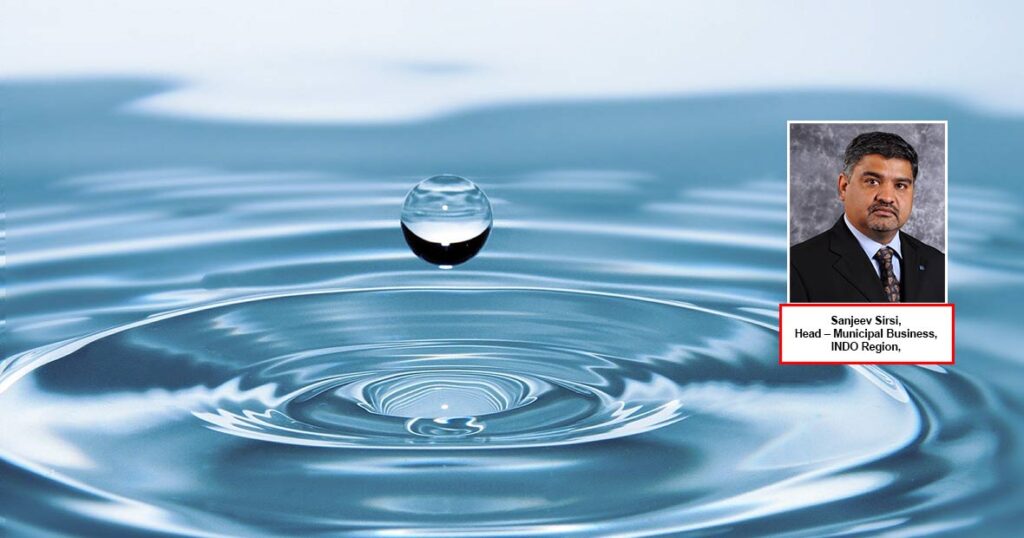In India, leakages, apparent losses due to the rising nonrevenue water (NRW) has been a major cause of concern for the water utilities segment. There are also various instances of pipe bursts and challenges due to inadequate water pressure coupled with poor quality of water. The impact of the pandemic has further increased the burden on our water utilities. Given the inadequate water utility infrastructure in our country, public health engineering departments have been doing their best to meet the current water demands.
To address these concerns, digitisation of water utilities will play an important role. Digital solutions will function on the principle of water per usage, aided through data driven models. These smart and intelligent solutions come with the ability to communicate a wealth of information – meter readings, machine health and more, all of which can help in adapting to the need of the system.
The differentiating factor – smart and intelligent solutions
Technologies for water utilities have evolved over time. Today, with the integration of digitisation and intelligent technology, we have come a long way from the days of manual intervention, i.e., checking pressure gauges, shifting of pipelines etc. With industry 4.0 technologies such as AI, machine learning, IoT and more, systems are completely automated. Tapping into such technologies will increase reliability of the water utilities’ operations.
With the onset of the pandemic, an increased need for switching to remote management of systems has become a necessity. Technologies such as Grundfos’ iSOLUTIONS that incorporates the aspects of IoT and AI cater to this need, by collecting accurate real-time data about the functioning of the water utilities network, helping reduce downtime and benefit from significant energy savings.
Similarly, Grundfos Remote Management system (GRM) is another tool for the purpose of monitoring a range of pumping systems. This tool can be used by utilities due to its high adaptability factor in which – the system’s components can be changed for accurate measurement based on situational parameters.
A standout example of this versatility comes from the Danish town of Hobro. After residents in one of the city’s neighborhoods complained about the lingering smell of hydrogen sulphide, authorities traced the odour to the manholes on the outskirts, where a pumping main was transporting wastewater. The production of the chemical was very severe (up to 500 ppm, as opposed to 0.0001 ppm in the atmosphere under clear conditions), and as hydrogen sulphide can seriously compromise the network pipelines, GRM was installed in the system. Compatible gas phase loggers were installed in the manholes and based on the data provided, GRM automatically calculated the correct dose of iron sulphate required. Thus, it eliminated the need for manual operation in what can potentially be a very hazardous work environment
When it comes to water utilities, they not only have the key function of providing the right quality of water but need to ensure wastewater is properly treated and discharged as well. Today, we can find various E-pumps such as RN pumps, NKG and NBG end-suction pumps or BM high-pressure booster modules that provide high filtration potential, helping keep the water from being hazardous. For example, the Daxing treatment plant in China, deals with treatment of the polluted water caused due to landfills. E-pumps have helped in the treatment of the effluents to such an extent that treated water can be directly discharged, and some of it can even be reused.
There is also a need to optimise the water pressure that is provided to the consumers. The current infrastructure sees many pipe bursts as well as leakages due to the uneven supply and pressure in the pipelines. With technologies such as the Demand-Driven Distribution (DDD) system, the entire infrastructure can be upgraded to address these concerns. This state-of-the-art system consists of high-efficiency pumps for water distribution, control panels and pressure sensors. The sensors, installed at critical points of the water network, measure pressure and flow based on local water consumption. This information is then sent back to the control panel at the water plant. Moreover, DDD is also a self-learning system and can thus adapt itself to recognise patterns in the network’s requirements over time.
In the Cambodian province of Takéo, the Takéo safe water supply plant was struggling to meet the needs of 45 villages and the city of DounKaev, with a combined population of 44,000 people. The company then partnered with Grundfos for a complete overhaul of its network and we promptly performed an audit and installed a DDD system with sensors at crucial points of the delivery system. Over time, the system learnt to predict the village’s consumption patterns from hour to hour and adjusted the overall system pressure or switched pumps on or off to compensate. The villages surrounding the water plant now have water 24 hours a day and residents no longer buy extra water. In fact, after one year, the plant has achieved over 20 percent savings in energy use, 13 percent reduction in NRW water losses due to leakages, and a 29 percent reduction in pipe bursts.
Going further with digitisation
The future of water utilities lies in digitisation. Systems that function by analysing data in real time, will enable the water utility segment to perform predictive and remote maintenance of infrastructure. This in turn will create a reliable system providing uninterrupted service, minimal downtime, and massive energy savings.
Moving forward, the digitisation of the water and wastewater will most importantly focus on providing water security in the country. Adoption of digital solutions will ensure that there is equity and access to water across the country and also ensure that our wastewater is treated, reused or discharged properly.
Expertise shared by: Sanjeev Sirsi, Head – Municipal Business – INDO Region, Water Utility, Grundfos India
Cookie Consent
We use cookies to personalize your experience. By continuing to visit this website you agree to our Terms & Conditions, Privacy Policy and Cookie Policy.

















